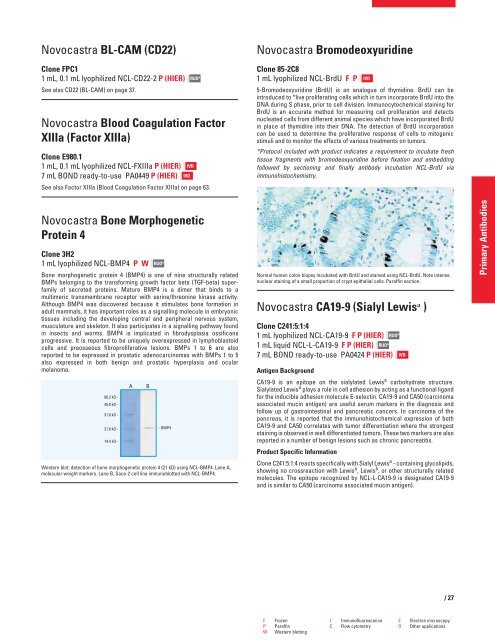QF0159 Marketing Release Record
QF0159 Marketing Release Record
QF0159 Marketing Release Record
You also want an ePaper? Increase the reach of your titles
YUMPU automatically turns print PDFs into web optimized ePapers that Google loves.
Novocastra BL-CAM (CD22)<br />
Clone FPC1<br />
1 mL, 0.1 mL lyophilized NCL-CD22-2 P (HIER)<br />
See also CD22 (BL-CAM) on page 37.<br />
Novocastra Blood Coagulation Factor<br />
XIIIa (Factor XIIIa)<br />
Clone E980.1<br />
1 mL, 0.1 mL lyophilized NCL-FXIIIa P (HIER)<br />
7 mL BOND ready-to-use PA0449 P (HIER)<br />
See also Factor XIIIa (Blood Coagulation Factor XIIIa) on page 63.<br />
Novocastra Bone Morphogenetic<br />
Protein 4<br />
Clone 3H2<br />
1 mL lyophilized NCL-BMP4 PW<br />
RUO*<br />
Bone morphogenetic protein 4 (BMP4) is one of nine structurally related<br />
BMPs belonging to the transforming growth factor beta (TGF-beta) superfamily<br />
of secreted proteins. Mature BMP4 is a dimer that binds to a<br />
multimeric transmembrane receptor with serine/threonine kinase activity.<br />
Although BMP4 was discovered because it stimulates bone formation in<br />
adult mammals, it has important roles as a signalling molecule in embryonic<br />
tissues including the developing central and peripheral nervous system,<br />
musculature and skeleton. It also participates in a signalling pathway found<br />
in insects and worms. BMP4 is implicated in fibrodysplasia ossificans<br />
progressive. It is reported to be uniquely overexpressed in lymphoblastoid<br />
cells and preosseous fibroproliferative lesions. BMPs 1 to 6 are also<br />
reported to be expressed in prostatic adenocarcinomas with BMPs 1 to 5<br />
also expressed in both benign and prostatic hyperplasia and ocular<br />
melanoma.<br />
Western blot: detection of bone morphogenetic protein 4 (21 kD) using NCL-BMP4. Lane A,<br />
molecular weight markers. Lane B, Saos-2 cell line immunoblotted with NCL-BMP4.<br />
IVD<br />
RUO*<br />
IVD<br />
Novocastra Bromodeoxyuridine<br />
Clone 85-2C8<br />
1 mL lyophilized NCL-BrdU FP<br />
5-Bromodeoxyuridine (BrdU) is an analogue of thymidine. BrdU can be<br />
introduced to *live proliferating cells which in turn incorporate BrdU into the<br />
DNA during S phase, prior to cell division. Immunocytochemical staining for<br />
BrdU is an accurate method for measuring cell proliferation and detects<br />
nucleated cells from different animal species which have incorporated BrdU<br />
in place of thymidine into their DNA. The detection of BrdU incorporation<br />
can be used to determine the proliferative response of cells to mitogenic<br />
stimuli and to monitor the effects of various treatments on tumors.<br />
*Protocol included with product indicates a requirement to incubate fresh<br />
tissue fragments with bromodeoxyuridine before fixation and embedding<br />
followed by sectioning and finally antibody incubation NCL-BrdU via<br />
immunohistochemistry.<br />
Normal human colon biopsy incubated with BrdU and stained using NCL-BrdU. Note intense<br />
nuclear staining of a small proportion of crypt epithelial cells. Paraffin section.<br />
Novocastra CA19-9 (Sialyl Lewis a )<br />
Clone C241:5:1:4<br />
1 mL lyophilized NCL-CA19-9 F P (HIER)<br />
1 mL liquid NCL-L-CA19-9 F P (HIER) RUO*<br />
7 mL BOND ready-to-use PA0424 P (HIER)<br />
Antigen Background<br />
CA19-9 is an epitope on the sialylated Lewis a carbohydrate structure.<br />
Sialylated Lewis a plays a role in cell adhesion by acting as a functional ligand<br />
for the inducible adhesion molecule E-selectin. CA19-9 and CA50 (carcinoma<br />
associated mucin antigen) are useful serum markers in the diagnosis and<br />
follow up of gastrointestinal and pancreatic cancers. In carcinoma of the<br />
pancreas, it is reported that the immunohistochemical expression of both<br />
CA19-9 and CA50 correlates with tumor differentiation where the strongest<br />
staining is observed in well differentiated tumors. These two markers are also<br />
reported in a number of benign lesions such as chronic pancreatitis.<br />
Product Specific Information<br />
Clone C241:5:1:4 reacts specifically with Sialyl Lewis a - containing glycolipids,<br />
showing no crossreaction with Lewis a , Lewis b , or other structurally related<br />
molecules. The epitope recognized by NCL-L-CA19-9 is designated CA19-9<br />
and is similar to CA50 (carcinoma associated mucin antigen).<br />
F Frozen I Immunofluorescence E Electron microscopy<br />
P Paraffin C Flow cytometry O Other applications<br />
W Western blotting<br />
IVD<br />
RUO*<br />
IVD<br />
/27<br />
Primary Antibodies
















